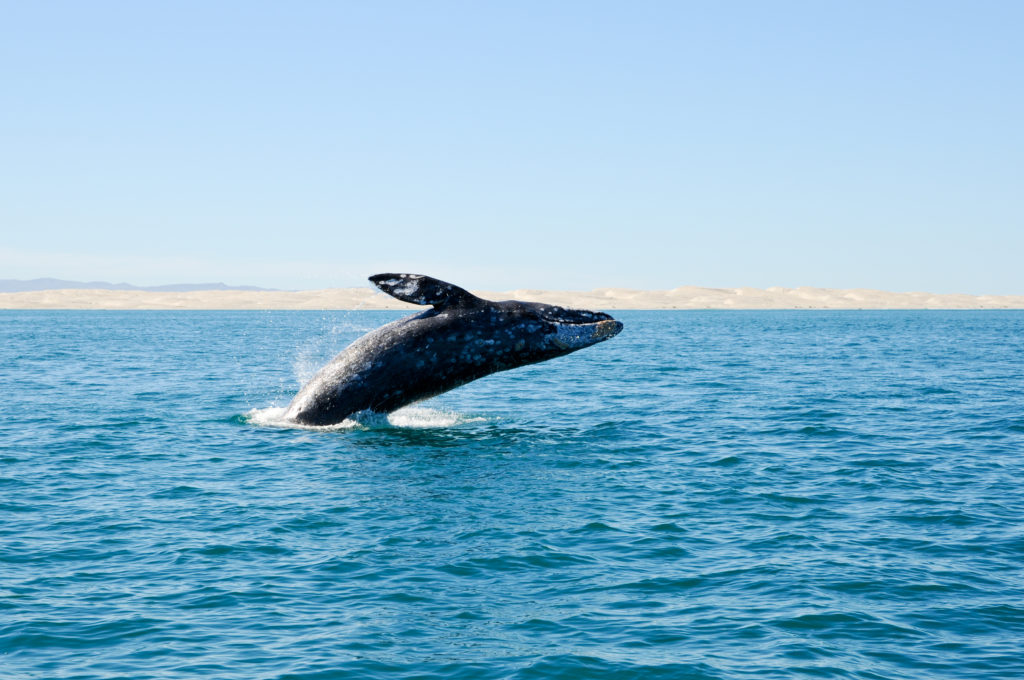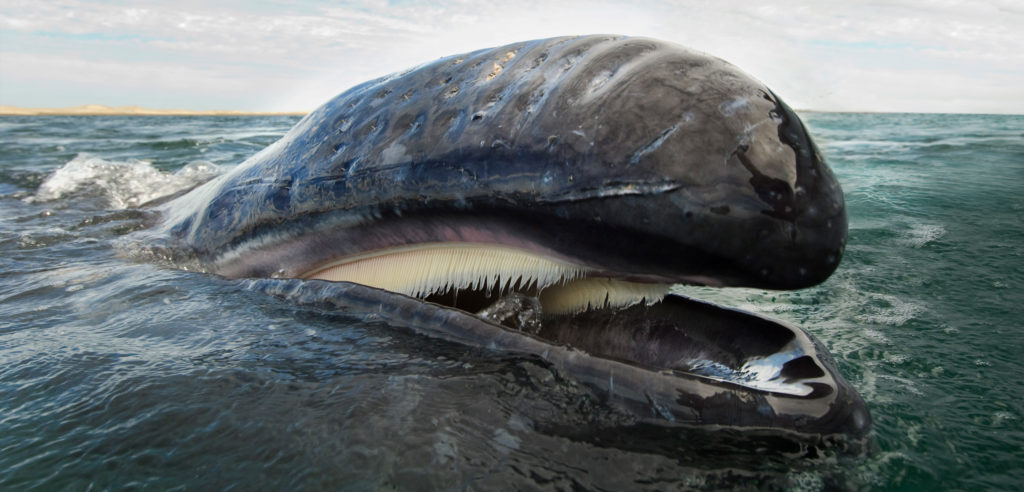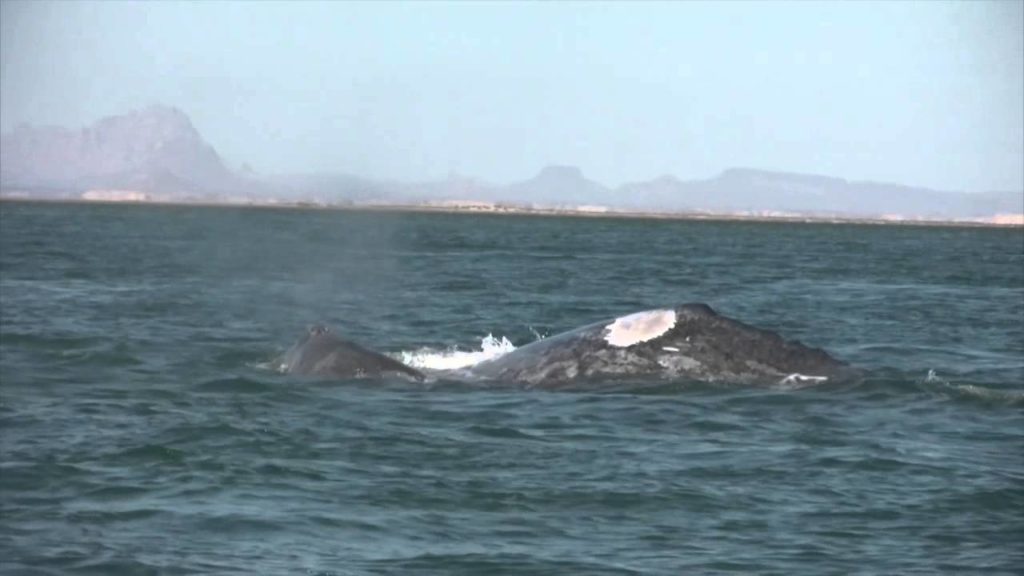The gray whales (Eschrichtius Robustus) are mysticetes cetaceans which belong to the Eschrichtiidae family. Let´s learn everything about them.
According to the information available, this species has an acceptable state of conservation, so, they are not considered a species at risk of extinction. They are one of the medium-sized whales that only inhabit the northern area of the Pacific Ocean.
Table Of Content
Main Characteristics
Among the main characteristics of this species we should start mentioning that this creature can measure up to 15 meters in length reaching a weight of 20 tons on average. (see article The Biggest Whales of the World : )
Regarding more specific measures, in the case of the malesgray whales, they usually reacheup to 14 meters length at most; being this way smaller than females, which usually reach 15 meters as their maximum length.
It is also important to know, that either males or females gray whales, reach a maximum length of up to 5 meters, when they are born. Although there are some differences between the genera in terms of length, the weight usually remains the same in both, the male and the female gray whale.
 As their name indicates, gray whales are easy to identify, due to the color of their bodies; which present different shades of gray, as well as some irregular spots in white. These features make a pattern for this species, allowing to differentiate them from others species. In the same way as other species of whales, this creatures have a fusiform figure. Moreover, it is necessary to mention that their body is covered with barnacles and others types of parasitic crustaceans.
As their name indicates, gray whales are easy to identify, due to the color of their bodies; which present different shades of gray, as well as some irregular spots in white. These features make a pattern for this species, allowing to differentiate them from others species. In the same way as other species of whales, this creatures have a fusiform figure. Moreover, it is necessary to mention that their body is covered with barnacles and others types of parasitic crustaceans.
In addition, we must also mention, that gray whales in some cases , present protuberances that end up on the tail. According to different evidences, these specimens don´t have a dorsal fin, but a small Hump formed by a kind of knuckles, which makes even easier to differentiate this species from others whales.
Once the gray whales become adult, they develop some scars, and they are usually accompanied by remoras, which makes fade their gray color. Their head is relatively small, compared to other species, and it´s usually tilted forward due to a pair nasal holes. The elongated mouth of the gray whales which starts from the head, and is curved upward, must be mentioned as another distinctive feature of this species, (see article: types of whales: names, characteristics and more )
Now, we recomend you this video to learn more about these striking and lovely whales….
The Gray Whales’ Common Behavior
We must start mentioning that unlike others species, the gray whales live in small groups made up of only 3 or 5 members. They tend to maintain this social structure during their whole life. However, in some occasions some members of these groups may migrate to others groups, looking for a couple but this is not very common. The Eschrichtius Robustus have the ability to swim at high speeds. Moreover, several investigations that have been carried out about this matter, ensure that this practice is related to their needs of eliminating parasites in their body.
Finally but not less important, you should know that these specimens are characterized for being actives and friendly creatures, who frequently visit vessels
The Gray Whales’ Habitat
The gray whales unlike other species, tend to be located close to coastal areas, it is weird to see them more than 20 or 30 km out to sea, and this is the reason why they are the most seen whale species in the world.
Since they are cetaceans, gray whales have adapted their skills and needs, to develop completely in the aquatic environment. So, when they are in their natural habitat, the gray whales tends to submerge to 100 meters deep, developing each stage of their life cycle at this depth.
They emerge whenever it’s necessary to breathe through two holes that they have in the top of their head.
Another reference regarding their habitat, is that there are two main populations of these specimens. One of them is relatively small, and they live in the Pacific Ocean, traveling frequently between the Sea of Okhotsk and South Korea. The other one is quite bigger than the first one, and they travel between the waters,that belong to Alaska and Baja California del Sur.
There is an interesting fact about another important population group, that lived in the North Atlantic but disappeared 300 years ago.
Gray Whales in Mexico
Every year an important group of gray whales, pass through the Mexican Areas of the Pacific Ocean. They usually make a migration, which is known as their big annual trip.
Their Areas of Reproduction in Mexico
The Gray Whales migration , is one of the biggest displacements in the marine world. During this trip, they go to the San Ignacio Lagoon on Mexico’s Baja Peninsula for reproductive purposes. According to the local media reports, this fact takes place in December, and they remain at this location until the end of that month. Then they continue their journey, toward the northern areas of the Bering Sea..
Sightings of Gray Whales
The afore mentioned facts, have made of these whales one of the most attractive events for people and tourists. So, many laws have been established, for their protection while they are near the coast with their offspring allowing them in this way to survive and adapt to a natural environment. There also many references from different ports, where gray whales have been seen making jumps, when they reach the waters of Mexico.
Gray Whales’ Alimentation Habits
Their diet is mainly based on crustaceans, specifically in krill, which are positioned at the end of the food chain. They usually resort to the bottoms of sea mud, capturing their food with their snout, absorbing this way all the food available. Then they make a sort of filtering process, to expel from their mouth all the excess of mud or water that is not considered food. They use their beards to carry out all this process.
Another very interesting fact is that in order to satisfy their alimentary needs, the gray whales consume up to 1 ton of food on a daily basis. As we have already mentioned, their diet is based on krill and others tiny and invertebrate creatures from the seabed.
Since they are mysticetes cetaceans, the traveler whales are also characterized by having beard. This can be described as a part of their body, similar to short yellow blades, which hang from the upper edge of their jaw. Due to their characteristics, the beards can be considered as a kind of teeth, which can reach a total length of up to more than 50 centimeters.
These beards facilitate the entire feeding process of these creatures, working as a sort of filter or strainer.The grey whales suck a lots of mud, water and other particles, expelling later all the wastes,which in turn benefits the seabirds.
¿How Do Gray Whales Mate ?
According to all the studies developed, regarding the reproductive process of the gray whales, it can be said that it is one of the most complex processes, compared to those of other whale´s species. The gray whales carry out, an entire process of courtship in addition to the reproduction that takes place.
Another important characteristic, is that the gray whales usually reach their sexual maturity, between eight or nine years old . However, the age is not the only factor that influences for reaching their sexual maturity. Several investigations indicate, that the reproduction takes place when the gray whales reach at least 36 meters length; which occurs when they are  between 5 years and 11 years old. All this happens as part of their annual migration trip . It is also important to know, that usually the females carry out this whole process ,with more than one male, seeking for higher possibilities of conception. Once a successful conception has been obtained, the gestation lasts more than a year. According to the references in this topic , the mating of these interesting creatures usually occurs in the Lagoon of San Ignacio, in the Magdalena Bay and in the entire coast of Baja California del Sur in Mexico. Different researches indicate, that this is because the gray whale species, prefer to be in warm water, for all their reproductive process.
between 5 years and 11 years old. All this happens as part of their annual migration trip . It is also important to know, that usually the females carry out this whole process ,with more than one male, seeking for higher possibilities of conception. Once a successful conception has been obtained, the gestation lasts more than a year. According to the references in this topic , the mating of these interesting creatures usually occurs in the Lagoon of San Ignacio, in the Magdalena Bay and in the entire coast of Baja California del Sur in Mexico. Different researches indicate, that this is because the gray whale species, prefer to be in warm water, for all their reproductive process.
In the same way, this theory gives the answers in relation about why they make their long migrations every year. It is also known, that the female gray whales, gives birth only once every two years. This whole reproductive process, results in a single offspring, which develops in the womb of its mother for at least 12 months.
Once the entire gestation process has finished, the birth takes place in the water ( as in the case of most cetaceans ). This means, that the offspring are able to swim when they are born. They are also characterized by having a gray coloration, which is darker than that of the adult whales. Then the babies whales, in order to accomplish their entire development process, maintain an specific diet of nutrients, provided from breast milk. This diet usually lasts 6 months.
It is also known that the babies gray whales, stay with their mother during the first two years of life.
On the other hand, the father doesn´t not have any type of influence in the care of the offspring, and that is why he can mate with several females.
The Gray Whales’ Migration
One of the main aspects that distinguish the gray whale species , is their huge migration journey carried out annually. This fact makes of them one of the most sighted whales around the world. According to the investigations that have been made in this regard, gray whales cover a distance of more than 15000 km ( even 20000 km, in some occasions) during this trip. Many experts have stated that the sum of all these travels during the gray whales´ life equals a round trip to the moon.
The migration journey is intended to ensure the procreation and reproduction of the gray whale species, which is another important fact. This travel begins in the in the bays of Mexico, where all the reproductive process takes place, and the females give birth their offspring. Then they travel to the northern areas of the Bering Sea, which is bordered to the North and East with Alaska, and on the West by Russia. The Grey Whales feed during the summer season at the Bering Sea.
The gray whales remain in Mexico for breeding purposes, since December until the end of April. However, the males and females without brood, begin their retirement in February, while the mothers stay with their offspring for another weeks until the month of April.
We inivite to watch this stunning video, to become part of the gray whales’ migration journey ….
Gray Whales Endangered
As we mentioned previously, there are two important groups of grey whales, one larger than the other. It must be taken into account, that the group corresponding to the population, that lies between the Ojotsk sea and South Korean has less than 130 individuals.
On the other hand, the group located between the waters of Alaska and Baja California Sur (see article: Whales in danger of extinction ) , is made up of more than 22,000 individuals.
According to these facts , it can be said that the western population is in danger of extinction, since few mating and procreation processes; have been recorded since 2010.
Moreover, there has been a significant number of females’ deaths, which has generated a considerable decline in the population.
Due to the gray whales’ social behavior ,which keeps them swimming near the coastal areas, they were considered as extinct, by the end of the XIX century and the XX century. The fact of being overexploited, generated this belief. However, in 1911 the species of gray whale was rediscovered (see article: humpback whale ) .
Thus, by the year 1947 the International Whaling Commission, declared the gray whales as protected species. For this reason, in comparison to past centuries, these species are currently quite protected. However , they are considered as the main  attractions for tourism, in some cities of Mexico. There are many laws, that currently protect this species from potential threats
attractions for tourism, in some cities of Mexico. There are many laws, that currently protect this species from potential threats
In this way, since it is one of the most protected species of whales, according to the previous facts; relevant studies have been carried out, to control their population in order to increase it.
In this sense, according to many references, there was an estimated population of almost 13.000 specimens by 1968. Later in 1998, the population of this species had been increased considerably, reaching more than 26000 whales.
This means that in only 30 years, the gray whales´ population increased a little more than twice. The responsibility of the pertinent entities, for the conservation of this species within its natural habitat, has been a key factor.
However, according to different studies that have been developed, it has also been proven, that there are still many threats for these mammals. The behavior they maintain, of inhabiting the coastal areas; makes them more susceptible ( according to specialists) , to the impacts caused by human activities. This problem is very common, especially in the areas where they feed, and during all the migration that they carry out. In addition, there are others natural factors, such as the case of the three gray whales, that were trapped under the ice in Alaska, in 1988,
The fact of inhabiting near oil and gas exploitation and exploration areas, is another threat for gray whales. Moreover, human activities are quite common, in all areas where there is a considerable marine traffic. For this reason, many of the human activities can mean huge threats for this species.
Albino Gray Whale
There are references, about an albino gray whale in a lagoon in Mexico.
The first information about this fact, corresponded to the Federal Attorney of Environmental Protection in Mexico. This entity informed about the sighting, of an albino offspring of the gray whale species; which was specifically in the lagoon “ Ojo de Liebre”, this means in the Northwestern area of the State of Baja California Sur.
In their report the entity specified, that the offspring had been found in perfect health; and had at least a week of being born. In the same way, the baby whale was accompanied by its mother.
 All this happened during a census, that was carried out on a regular basis, to have accurate information about the breeding and mating ,that gray whales perform in that lagoon; especially during the months between December and April.
All this happened during a census, that was carried out on a regular basis, to have accurate information about the breeding and mating ,that gray whales perform in that lagoon; especially during the months between December and April.
This fact amazed the relevant entities, since it is rare to find a baby mammal; with the genetic condition of albinism. This condition is generated by a reduction of the melanic pigment.
This specimen of gray whale, caught the attention of many specialists; that were working in the lagoon “Ojo de Liebre”.
The baby whale, was seen more than once, swimming with her mother in the referred waters; it was called sack of salt, due to her weird appearance.
Shortly after, she was found lifeless on shores , and the entity reported that the body of the animal was found, in a state of decomposition. of several days.
After applying the relevant studies , it was concluded that the cause of the death, was not related with human activities (see article: blue whales)
Taking into account, that albinism is a defect in the animal’s genetics, several specialists assured; that in addition to a drastic change in the tone of the body, albinism can also be responsible for other diseases in some species ; such as problems with the vision. In the same way, it is considered that an albino baby whale, could be more vulnerable in its natural habitat; the possible predators and the different threats.
Finally, we invite you to watch this video, so you´ll fall absolutely in love; with these awesome creatures.…
Https://www.youtube.com/watch?v=CAJNa2dOLoI







